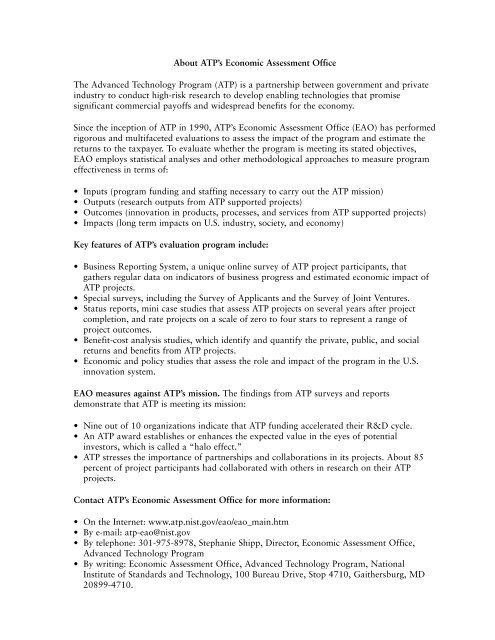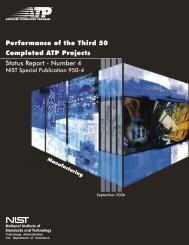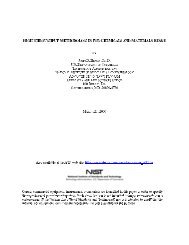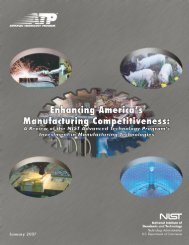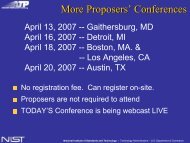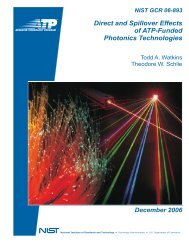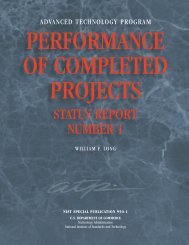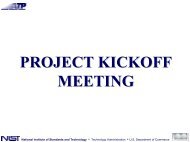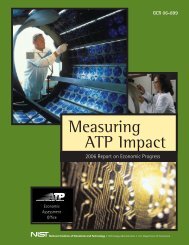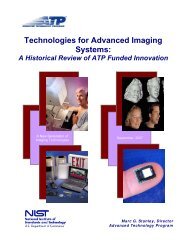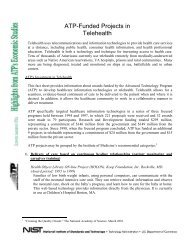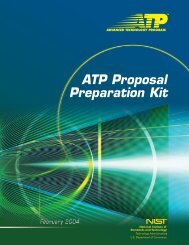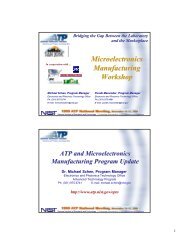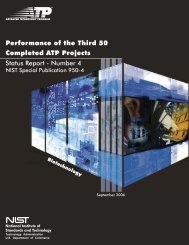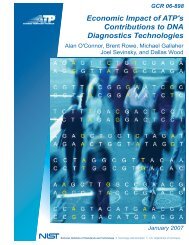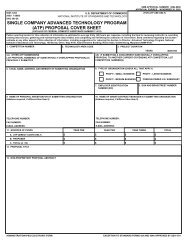ATP-Funded Green Process Technologies - NIST Advanced ...
ATP-Funded Green Process Technologies - NIST Advanced ...
ATP-Funded Green Process Technologies - NIST Advanced ...
Create successful ePaper yourself
Turn your PDF publications into a flip-book with our unique Google optimized e-Paper software.
About <strong>ATP</strong>’s Economic Assessment Office<br />
The <strong>Advanced</strong> Technology Program (<strong>ATP</strong>) is a partnership between government and private<br />
industry to conduct high-risk research to develop enabling technologies that promise<br />
significant commercial payoffs and widespread benefits for the economy.<br />
Since the inception of <strong>ATP</strong> in 1990, <strong>ATP</strong>’s Economic Assessment Office (EAO) has performed<br />
rigorous and multifaceted evaluations to assess the impact of the program and estimate the<br />
returns to the taxpayer. To evaluate whether the program is meeting its stated objectives,<br />
EAO employs statistical analyses and other methodological approaches to measure program<br />
effectiveness in terms of:<br />
• Inputs (program funding and staffing necessary to carry out the <strong>ATP</strong> mission)<br />
• Outputs (research outputs from <strong>ATP</strong> supported projects)<br />
• Outcomes (innovation in products, processes, and services from <strong>ATP</strong> supported projects)<br />
• Impacts (long term impacts on U.S. industry, society, and economy)<br />
Key features of <strong>ATP</strong>’s evaluation program include:<br />
• Business Reporting System, a unique online survey of <strong>ATP</strong> project participants, that<br />
gathers regular data on indicators of business progress and estimated economic impact of<br />
<strong>ATP</strong> projects.<br />
• Special surveys, including the Survey of Applicants and the Survey of Joint Ventures.<br />
• Status reports, mini case studies that assess <strong>ATP</strong> projects on several years after project<br />
completion, and rate projects on a scale of zero to four stars to represent a range of<br />
project outcomes.<br />
• Benefit-cost analysis studies, which identify and quantify the private, public, and social<br />
returns and benefits from <strong>ATP</strong> projects.<br />
• Economic and policy studies that assess the role and impact of the program in the U.S.<br />
innovation system.<br />
EAO measures against <strong>ATP</strong>’s mission. The findings from <strong>ATP</strong> surveys and reports<br />
demonstrate that <strong>ATP</strong> is meeting its mission:<br />
• Nine out of 10 organizations indicate that <strong>ATP</strong> funding accelerated their R&D cycle.<br />
• An <strong>ATP</strong> award establishes or enhances the expected value in the eyes of potential<br />
investors, which is called a “halo effect.”<br />
• <strong>ATP</strong> stresses the importance of partnerships and collaborations in its projects. About 85<br />
percent of project participants had collaborated with others in research on their <strong>ATP</strong><br />
projects.<br />
Contact <strong>ATP</strong>’s Economic Assessment Office for more information:<br />
• On the Internet: www.atp.nist.gov/eao/eao_main.htm<br />
• By e-mail: atp-eao@nist.gov<br />
• By telephone: 301-975-8978, Stephanie Shipp, Director, Economic Assessment Office,<br />
<strong>Advanced</strong> Technology Program<br />
• By writing: Economic Assessment Office, <strong>Advanced</strong> Technology Program, National<br />
Institute of Standards and Technology, 100 Bureau Drive, Stop 4710, Gaithersburg, MD<br />
20899-4710.


